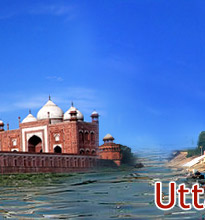 350
years ago, when the Taj was built on the Yamuna's south bank, a
moonlight garden called Mehtab Bagh was also laid just across the river.
It was laid alongside the northern waterfront. The place was once an
oasis with fragrant flowers, shaded pavilions, fountain jets and
reflecting pools but it ceased to exist in the due course of history.
Slowly, the site became barren.
350
years ago, when the Taj was built on the Yamuna's south bank, a
moonlight garden called Mehtab Bagh was also laid just across the river.
It was laid alongside the northern waterfront. The place was once an
oasis with fragrant flowers, shaded pavilions, fountain jets and
reflecting pools but it ceased to exist in the due course of history.
Slowly, the site became barren.This 25-acre plot has now turned in to an epicenter for the apex court-ordered project to establish protective greenways around the Taj. As the land is reclaimed, historians and geographers from around the world are jostling to learn about the magnificent garden that once existed near this oasis. A breakthrough technology inspired from Iran has been applied to bloom the Mehtab Bagh once again.
This interest in Mehtab Bagh has developed due to the increasing concern for the Taj and its grounds, which are threatened by urban sprawl, too many tourists, and air pollution that eats away at the shrine's marble exterior. The lush gardens that once lined the riverbanks on either side of the Taj may be reincarnated in a scheme to shield it from further depredations. Conservationists maintain that a buffer zone of greenery would keep development at bay and help remedy local air, noise, and water pollution. Much of the land for the greenbelt had already been acquired through an earlier initiative to establish a 340-acre national park around the Taj.











